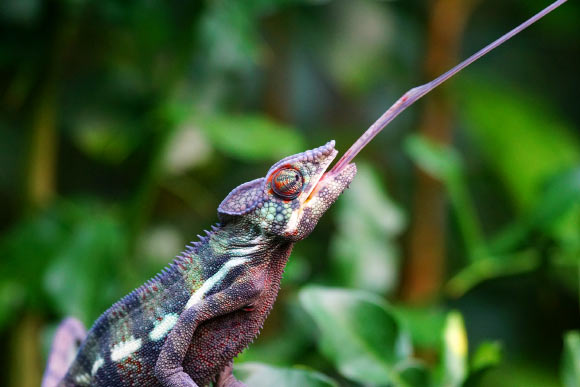The viscosity of the mucus secreted at the tip of a chameleon’s tongue is about 400 times higher than that of human saliva, according to a team of scientists led by Dr. Pascal Damman from the Université de Mons, Belgium.
Chameleons are small to mid-size tree-dwelling reptiles that are famous for their ability to change colors. They are found in the Old World, but most live in Madagascar and Africa.
These reptiles are opportunistic predators feeding on a large variety of invertebrate and vertebrate animals, ranging from ants to lizards.
They remain motionless, hidden from their own predators, and wait for active prey to come within the reach of a strike.
They are able to capture large prey (up to 30% of their own weight) by projecting the tongue at high acceleration (300 – 1,500 m/s2).
Once in contact with a prey, the tongue retracts with a comparable acceleration to bring it to the mouth.
A strong adhesion between the tongue tip and the prey is therefore required during the retraction phase to ensure a successful capture.
Dr. Damman and co-authors have demonstrated that the mucus produced at the chameleon’s tongue pad has a viscosity 400 times higher than that of human saliva.
“To investigate the mechanism responsible for this strong bond, the viscosity of the mucus produced at the chameleon’s tongue pad is measured, using the viscous drag exerted on rolling beads by a thin layer of mucus,” they explained.
The tongue’s deformability during projection, producing a large contact area with the prey, together with this viscous liquid, form a particularly efficient adhesive weapon.
The scientists used mechanical tools combined with tongue morphology measurements to demonstrate that the viscous adhesion built up during a capture is large enough to catch prey with a high mass compared to that of chameleons.
The team’s dynamical model compares favorably with experimental data on the maximum prey mass with respect to the chameleon size.
The results, published in the journal Nature Physics, also provide a new methodology for studying prey prehension by other predators, such as salamanders or toads.
_____
Fabian Brau et al. Dynamics of prey prehension by chameleons through viscous adhesion. Nature Physics, published online June 20, 2016; doi: 10.1038/nphys3795








